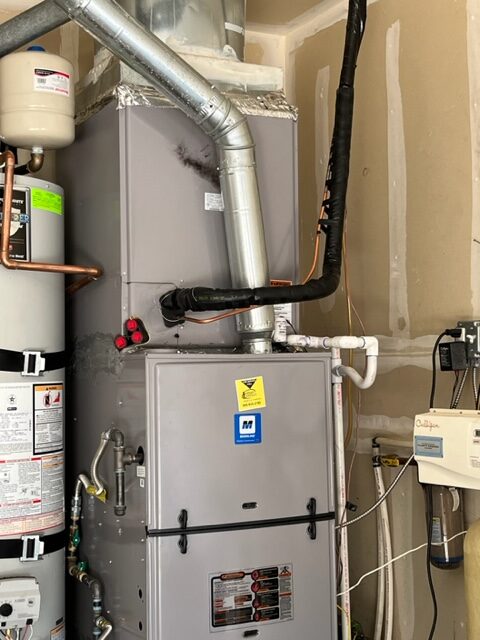
Summers are the worst when the AC dies. And you literally can’t function when the heat stops working in the dead of winter.
At some point, it’s clear those old machine need to be replaced. But when one system bites the dust before the other, it’s tempting to just swap out the broken one and keep it operating for more.
However, replacing both your AC and furnace at the same time has some compelling benefits that are worth exploring before you make a decision.
In this article, we’ll go over the main reasons getting both an AC and furnace replacement together is advantageous, along with potential drawbacks to be aware of.
Why You Should Consider the AC/Furnace Double Play
Replacing your AC and furnace simultaneously can upgrade your home’s temperature control. Here’s the deal on why it’s often worth it:
More Efficient Systems and Lower Bills
Today’s AC units and furnaces are way more energy smart than even those from 10-15 years back. The latest models require much less juice to run, so you’ll save some sweet coin on energy. When picking a new AC, you can compare efficiency by peeking at the Seasonal Energy Efficiency Ratio aka SEER. The higher the SEER, the less electricity it uses.
The federal government makes manufacturers meet certain minimums. Right now, ACs in northern states need a 14 SEER rating. Down south it’s 15. So if you’re AC shopping soon, be sure to get one that meets the standard for your area. That’ll keep it running optimally for years before needing a swap out again.
For furnaces, check out the Annual Fuel Utilization Efficiency or AFUE. You want that number at 90% or above for max efficiency. Boilers and heat pumps have slightly different targets. In general, a modern furnace easily lasts 15-20 years, while central ACs tend to survive 12-15 years depending on build quality.
Mixing Old and New Isn’t Ideal
Connecting a shiny new system to an aging partner in crime can actually shorten its lifespan. Replacing just one part lowers the performance of both your heating and cooling setup. When you pair new tech with an outdated counterpart, you don’t get the full benefit of that new hotness.
It’s important to double check any warranty dates. Some manufacturers won’t honor a warranty if the new system breaks down when connected to an incompatible oldie.
Doing both swaps together makes sure your gear works perfectly together and avoids any warranty uncertainty.
Matched HVAC Systems Complement Each Other
Today’s AC and furnace models are designed to work seamlessly together as a system. The furnace heats the air while the AC unit cools it.
An efficient shared blower circulates air through perfectly balanced ductwork. Separating equipment replacement interrupts this synergy. Upgrading together maintains system symmetry for:
- Maximum energy efficiency – New models minimize energy waste for lower utility bills.
- Proper airflow and circulation – Matched capacities and ductwork optimize air movement.
- Fewer repairs – Components are sized for each other, reducing strain and breakdowns.
- Enhanced comfort – The system maintains desired temps with minimal fluctuation.
- Ideal humidity levels – Careful sizing prevents over-cooling that causes stuffy air.
- Peace of mind – Both units are under warranty if repairs are needed down the line.
- Greater lifespan – Components aren’t overworked so last longer before replacement is needed.
Cost Savings over the Long Haul
While upfront costs may be higher, a perfectly paired system saves money long-term by:
- Reducing energy consumption significantly, lowering utility bills.
- Avoiding premature repairs and breakdowns of mismatched equipment.
- Minimizing future labor costs by allowing complete access for ideal install.
- Qualifying for greater rebates and incentives offered for full system replacements.
- Potentially lasting years longer thanks to optimized compatibility between components.
- Maintaining the home’s value with an upgraded, warrantied HVAC system.
A Great Investment for Any Budget
The expense of replacing major appliances can seem daunting. But creative financing solutions make joint AC and furnace upgrades affordable at any budget level. Consider these cost-saving tips:
- Time upgrades for peak rebate seasons when credits can offset 30% or more of the project cost.
- Finance through your utility company and pay through monthly energy bill savings.
- Use a low-interest HVAC-specific credit card with 12-18 months to pay it off.
- Tap into home equity via cash-out mortgage refinancing or a HELOC.
- Ask your contractor about promotional financing with little to no interest.
- Pay half upfront and finance the rest interest-free over 6-12 months.
Any increase in cash outlay is an investment that pays off exponentially in year-round comfort and dramatically lower energy consumption. Crunching the numbers proves upgrading together saves substantially compared to staggering replacements.
Cost to Replace AC and Furnace
Here’s a general breakdown of what to expect:
- Furnace – $5,500 average, ranging $2,600 – $6,400
- Central AC Unit – $3,800 – $7,500, averaging around $5,500
- Furnace + AC Replacement Together – $7,500 average, usually $5,000 – $12,500
So, doing the full swap can save you some dough compared to buying and installing them separately. Double check with contractors, but often there are package deals for buying both appliances together too.
At the very least, you save on labor costs by only needing one installation job versus two down the line.


